Pioneer Park in Olympia, Washington, offers a serene escape into nature, right in the heart of the city. This accessible park features a captivating trail that meanders alongside the Deschutes River, providing an opportunity to witness diverse ecosystems and learn about local ecology. As you step onto the trail, you’re immediately greeted by the soothing sounds of the flowing river and the rustling leaves of the surrounding trees, inviting you to explore the natural wonders within Pioneer Park.
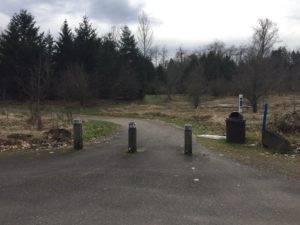 Trail Entrance to Pioneer Park Olympia Washington
Trail Entrance to Pioneer Park Olympia Washington
Exploring the River’s Natural Flow
As you begin your walk, you’ll notice the trailhead to your left, marked by a young grove of Douglas fir trees leading towards the river. It’s important to stay on the designated park trail to respect private property boundaries. Observing the Deschutes River, you might ponder how rivers naturally behave. In an undisturbed state, rivers are dynamic systems, meandering across landscapes as they journey towards the sea. This natural meandering is crucial for a healthy river ecosystem. Unfortunately, many rivers worldwide are now constrained by human interventions like dikes and dams, altering their natural flow. To understand more about the intricate world of rivers, resources like American Rivers and National Geographic offer valuable insights into river anatomy and the importance of free-flowing rivers. The Deschutes River, like other lowland South Sound streams, is primarily rain-dominant, meaning its flow is dictated by rainfall rather than snowmelt, resulting in its highest and fastest flows during winter and early spring.
Following the Deschutes River Trail
Continuing along the gravel path to your right, you’ll follow the Deschutes River downstream. Take a moment to consider the river’s journey – it eventually flows into Capitol Lake, passes through a dam, under the 5th Avenue bridge in Olympia, and finally merges with the saltwater of Budd Inlet in Puget Sound. Along the riverbanks, observe the deciduous trees that thrive in the moist soil. Red alders and black cottonwoods are common sights here, perfectly adapted to riparian environments. These trees play a vital role, providing shade, habitat for wildlife, and essential nutrients for the soil. You might notice sections of the riverbank reinforced with rip-rap – large boulders placed to prevent erosion. This rip-rap, while serving a purpose in flood control, often displaces the native vegetation that naturally supports local ecosystems. The vegetation that initially re-establishes in these disturbed areas can unfortunately be non-native, offering less optimal shelter and food sources for native wildlife compared to the original understory.
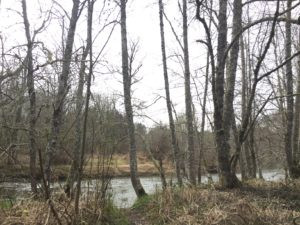 Red Alder Trees along Deschutes River at Pioneer Park Olympia Washington
Red Alder Trees along Deschutes River at Pioneer Park Olympia Washington
Riparian Revegetation and Wildlife Habitat
Keep an eye out for a sign detailing an Eagle Scout’s riparian revegetation project. This initiative highlights efforts to restore the natural streamside habitat. Riparian areas, the zones along water bodies, possess unique soil and vegetation influenced by the presence of water. They are critical for preventing erosion, mitigating flood impacts, and providing shade to keep the river cool, which is essential for aquatic life. These vegetated riparian zones are havens for diverse wildlife. Listen for bird songs, watch for garter snakes basking in the sun, and observe the movements of small mammals. Pioneer Park’s riparian zone can be home to various bird species, garter snakes, mice, raccoons, butterflies, and even deer.
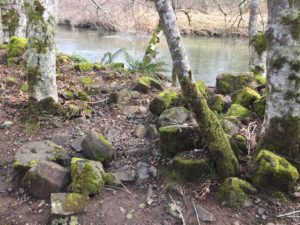 Rip Rap along the river bank at Pioneer Park Olympia Washington
Rip Rap along the river bank at Pioneer Park Olympia Washington
Junction and Evidence of Human Impact
As the paved path intersects with the trail, turn right and head back towards the parking lot, staying left on the paved section. Near the picnic table, examine the riverbank closely. Can you spot man-made elements? The rip-rap rock wall is a clear indicator of human intervention designed to control erosion. In areas where natural vegetation has been removed, rip-rap is often installed to protect the banks from being washed away by high water. The rocks effectively deflect the force of the water, reducing soil erosion.
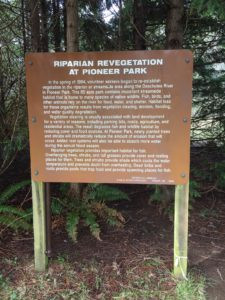 Riparian Revegetation Sign at Pioneer Park Olympia Washington
Riparian Revegetation Sign at Pioneer Park Olympia Washington
Returning to the River and Observing Erosion
Near the parking lot, take a left onto the wide gravel path and continue straight, past the life jacket sign. Upon reaching the river again, look both upstream and downstream. Can you identify areas where riverbank erosion is occurring? It’s crucial to maintain a safe distance from the bank here as the current is strong and the water deep. The erosion you observe is often exacerbated by the historical removal of native trees and shrubs. The roots of these plants would have naturally reinforced the soil, and the overhanging foliage would have lessened the impact of the water’s force. Currently, many locations experiencing erosion are undergoing restoration efforts, with landowners, agencies, and volunteers planting native vegetation. Human activities, such as farming, likely led to the removal of the original tree cover along the Deschutes River. Without trees, riverbanks become more susceptible to erosion, especially during floods. Trees are nature’s flood control and soil stabilizers. While erosion is a natural process in river systems, human interference accelerates it, leading to increased muddiness and wider river channels than would naturally occur. Pioneer Park serves as a reminder of the importance of riparian vegetation and the ongoing need for restoration.
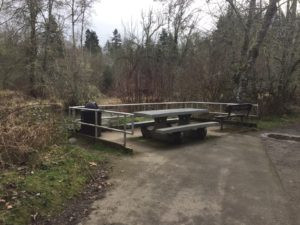 Picnic Bench Overlooking Rip Rapped River Bank at Pioneer Park Olympia Washington
Picnic Bench Overlooking Rip Rapped River Bank at Pioneer Park Olympia Washington
Conclusion: Appreciating Pioneer Park’s Ecosystem
Your exploration of Pioneer Park along the Deschutes River offers a valuable glimpse into river ecology and the delicate balance between human activity and natural processes. As you continue on the path and turn right at the gravel intersection to return to the parking lot, reflect on the importance of preserving and restoring riparian areas. Pioneer Park provides a wonderful opportunity to learn about these vital ecosystems and appreciate the natural beauty of Olympia, Washington.
